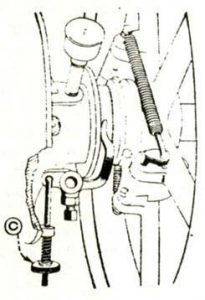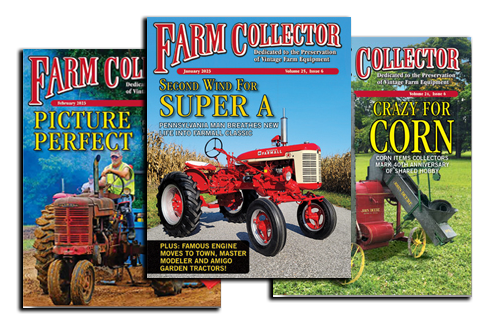Circa-1920 Aermotor 2-1/2 hp General Purpose Engine
Manufacturer: Aermotor Co., Chicago, Ill.
Year: Circa 1920
Serial Number: 1117.K
Horsepower: 2-1/2 @ 400rpm
Bore & stroke: 4-1/8in x 6in
Flywheels: 24in
Pulley: 8in x 6-1/2in
Ignition: Igniter w/battery and coil
Governing: Hit-and-miss
Cooling: Water w/fluted hopper
Weight : 600lb (approx.)
Price: $115 (1920)
Rural residents of the Texas Hill Country often get their weekly paper a day later than their neighbors living in town, so when Dierre Smith and his wife, Becky, looked at the paper that they just pulled out of the mailbox, they were dismayed to read that an estate sale was already underway to liquidate the worldly possessions of a couple who had lived on a nearby ranch. Dierre and Becky went to the sale as soon as they could, but many of the items had already been snapped up by eager buyers — especially the antique tools and implements that Dierre and Becky found most interesting.
Becky is especially interested in old boxes, and she was able to acquire a few wooden ones that appealed to her. When the Smiths inspected their new acquisitions after they arrived home, they found a cylindrical object in one of the boxes. At first glance, Dierre thought that it was a dry-cell battery that had been used in one of the old wall-mounted telephones. After closer inspection, however, he realized that it was actually the ignition coil from an old engine. Operating under the assumption that “Where there’s smoke, there’s fire,” Dierre and Becky hastily returned to the estate sale and inquired if there were any old engines for sale.
Lost and found
The woman in charge of the sale was the daughter of the previous owners, and she didn’t remember that there were any engines sitting around. But she did recall that there was “an old pump or something” sitting in one corner of the chicken coop and she invited the Smiths to take a look at it. As an afterthought, she mentioned that she thought her husband was interested in keeping whatever it was. When Dierre spotted the “old pump” his heart skipped a beat, because he instantly recognized the fluted hopper as the water hopper of an old Aermotor engine.
Becky and Dierre had for years been friends of the couple having the sale. Dierre knew where the husband worked, and he immediately drove there and offered as much for the engine as he felt that he could afford — plus a little more. The man indicated that he had been planning on restoring the engine, but just hadn’t gotten around to it. He said that he would think about Dierre’s offer for a few days.
Dierre counted down the hours and the minutes during the next few days and then contacted the owner of the engine. The man said that although he was interested in the engine, realistically he probably would never get around to restoring it, so he agreed to sell it. Without further hesitation, money changed hands and the deal was completed.
Aermotor
The Aermotor is well known as the company that has made windmills since 1888 (they’re still in business: www.aermotorwindmill.com), but fewer people remember that from the early 1900s into the 1940s the company also made gasoline engines. These included general purpose engines, such as the one Dierre acquired, and both small and large engines specifically designed to pump water. The engines were based on a design by La Verne W. Noyes, the founder of Aermotor Co., Chicago, Illinois.
Dierre’s Aermotor generates 2-1/2 hp at 400rpm. It has a 4-1/8-inch bore and a 6-inch stroke. Its two 24-inch flywheels weigh 100 pounds each and the total weight of the engine is approximately 600 pounds. In 1920, the engine sold for $115 with a battery and coil ignition. The number 1117.K is stamped on the side of the engine. An engine equipped with a magneto would have cost several dollars more. One of the tasks that the engine performed was to power a mechanical clipper to shear sheep. Unfortunately, Dierre and Becky arrived at the estate sale too late to acquire the clipper that had been used with this engine.
Typical of many early engines, the Aermotor is water-cooled. However, its appearance is distinctive because it has an open, galvanized-steel water hopper that is funnel-shaped and fluted to provide a large surface area to dissipate heat as rapidly as possible. This design is considered to be much more efficient than the cast-iron hoppers found on most early engines.
Also typical of other engines produced in the early 1900s, Dierre’s Aermotor is a hit-and-miss design. The exhaust valve is activated by a lever that is either held open or released by a governor to regulate the speed of the engine. The intake valve is an atmospheric type, pulled open by the vacuum caused by the piston descending within the cylinder during the intake stroke.
Dierre’s Aermotor has a “make-and-break” igniter mounted within the combustion chamber. The points are closed as an electrical charge builds up in the ignition coil during the engine’s compression stroke. Just before the piston reaches top-dead-center on the compression stroke and the fuel-air mixture is compressed to its maximum, the points separate and a spark jumps from one point to the other, igniting the fuel-air mixture and producing the combustion stroke that pushes the piston down the cylinder. The mechanism operating the exhaust valve also trips the igniter.
Dierre’s engine is typical of most Aermotors sold in that the electricity for ignition is provided by a battery. Aermotor engines with magnetos were also available, at additional cost.
Most of the bearings on Dierre’s Aermotor engine are lubricated through cups or pipes containing wicking soaked with oil. The connecting rod is the only bearing with a grease cup. This engine is painted burgundy; other Aermotor engines were painted dark green, red or gray.
The other general-purpose engine produced by Aermotor had a 5-inch bore and a 7-1/2-inch stroke. It’s two 30-inch flywheels each weighed 150 pounds and the total weight of the engine was 1,000 pounds. In 1920, the 5 hp engine sold for $155 with battery ignition and $165 with a magneto.
One of the more popular Aermotor pumping engines was a relatively small 1 hp engine. It was unique in that it was an 8-cycle engine. The cycles included intake, compression, ignition, exhaust, breathe, exhaust, breathe, exhaust. In other words, ignition occurred only once every four revolutions. Additional breathe and exhaust strokes were introduced as needed to govern the speed. During the extra strokes, the engine took in or expelled air through the muffler and open exhaust valve. Gasoline was taken in during the intake stroke, but only if the speed of the engine decreased to the point where the governor allowed the exhaust valve to close. Increased fuel efficiency was claimed with the 8-cycle design, and the extra strokes meant the engine ran cool and the air-cooled engine did not need a cooling fan. An optional camshaft was available to convert the engine to 4-cycle operation so that it could handle a heavy load such as a pump in a deep well.
Some small pumping engines incorporated gears with the engine to significantly increase the torque to the point where the small engine was able to move a sucker rod up and down in a well and push water up a pipe. The sucker rod and pipe extended through the base down into the well to a pumping cylinder and foot valve below the water level. The engine and pump with a cast-iron base cost $58 with battery ignition and $64 with a magneto. This engine and pump was especially suited for operation in cold climates and for pumping water a long distance.
A unique feature of some Aermotor pumping engines was that they had small fuel tanks mounted directly on their carburetors. This enabled an operator to add only the amount of gasoline necessary to run an engine long enough to complete a given task, such as filling a water tank. The operator could start the engine and leave it unattended, knowing that the engine would shut itself off once the task was completed.
Larger Aermotor pumping engines were sometimes cooled with well water and didn’t have water hoppers. These engines were often mounted over pumps located in pits under the engines.
The first Aermotor windmill was introduced in 1888, based on a design by Thomas O. Perry, and the Aermotor Co. has been a leader in the windmill field ever since. The company was based in Chicago for more than 70 years. Following a series of sales the company was moved to Broken Arrow, Oklahoma, then to Conway, Arkansas, and finally to San Angelo, Texas, where it is currently located. Manufacturing was moved to Argentina in 1969, but returned to the U.S. in 1980. The company is currently owned by a group of West Texas ranchers and has expanded to produce water pumps and solar-powered products. It remains the only company in the U.S. that manufactures windmills, and its products are sold worldwide.

















